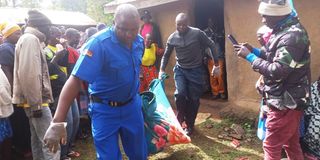Primitive attacks on women an indictment of society

Police officers carry the body of Zainabu Shiunzi, 56, from her house. She was hacked to death by unknown people in Elwanda village, Mumias, on March 21, 2023.
What you need to know:
- In some cases, widows are targeted for killing using the witchcraft handle as a means of alienating the land they occupy.
- Those who have a duty of protection but do not exercise it are guilty of violence by omission.
It was a heart-rending story by Mwangi Muiruri (Daily Nation, March 12, 2023). At about 10.30pm on February 20, an inebriated gang descended on the mud-walled hut of Mwangi Kibaara and his 75-year-old wife, Mary Njoki, in Murang’a County with a single mission: to eliminate her because of allegations that she was the master-witch in Kiamikoe village.
Frantic efforts by Kibaara to protect her—including an offer to migrate—fell on deaf ears as Njoki was battered, bedecked with two tyres, and burned to ashes. The gang even undressed her, an abomination in African culture, notwithstanding the curse by Kibaara.
That the police only arrived to take away the charred remains several hours later, and that no arrests had been made three weeks after the event, justifies Kibaara’s loss of confidence in the government.
“The government is as guilty as the mob; my wife was tortured for two hours before she was lynched,” he is reported to have said.
These words strike at a cardinal point, that those who have a duty of protection but do not exercise it are guilty of violence by omission.
Njoki is just the latest victim of gender-based violence, rooted, as they are, in unequal power relations between helpless older persons and users of brute force. The victims are often: of low status; old, hence physically defenceless; poor and, therefore, least influential; and living alone.
In some cases, widows are targeted for killing using the witchcraft handle as a means of alienating the land they are occupying. Regrettably, older persons have few, if any, community-based organisations to defend their rights. Attacking them is just another step in the continuum of marginalisation they already face.
A Helpage International evaluation report on the Sukumaland Older Women’s Programme in Magu District, Tanzania (though dated), sheds some light on how frivolous witch-hunting is. It shows that perpetrators often based their allegations on divinations by traditional healers consulted on the causes of their misfortunes and who invariably pointed at red-eyed old women in the village.
In actual fact, the red eyes were results of lifelong use of open fireplaces by women carrying out their gender roles of cooking for families! In one case, an outbreak of dysentery was blamed on an older woman who fetched water from the local river early in the morning when it was still cool. She was accused of poisoning the river. How can someone poison the same water she uses for her consumption?
These primitive attacks on women result in death and other consequences for survivors. These include expensive hospitalisation, loss of domicile and property, permanent disfigurement, loss of productivity, stigma, psychological trauma, constant fear, suspicion and latent conflicts.
One wonders why those who accuse others of witchcraft cannot report them for legal action! This brings to mind The Witchcraft Act of 1925, Cap 67 of the Laws of Kenya.
Legal gap
A 2015 academic paper by Munyuga Mwangi demonstrates how useless this piece of legislation is. It ostensibly seeks to prohibit witchcraft without even defining it. This means it is prohibiting an imaginary activity.
The Act states that “the District Commissioner may order a person practising witchcraft to reside in a specific area within the district”. This essentially means that the law accepts the practice as long as the practitioners are sequestrated. This reminisces of Ghana where such reserves are called “witch camps”.
Attacks similar to that on Njoki were reported in Mokona village, Marani ward, Kisii County, on October 17, 2021. A consortium of 22 civil society organisations that condemned the attacks noted that the lynching begins with labelling of a person as a witch.
In line with the saying that if you want to hang a dog, start by giving it a bad name, this stimulates a search for evidence. Thus it is only a matter of time before a “victim” surfaces.
Reacting to these cases, the Kenya National Commission on Human Rights reported that it receives up to four monthly cases of elderly women being killed over alleged witchcraft from each of the counties of Kisii, Kilifi and Kwale, meaning a total of 144 in a year.
Eradication of these attacks requires a multi-dimensional approach that includes enforcement of the law, administrative action, community-level mobilisation, civic education on harmful beliefs and the creation of awareness of the rights of older persons.
Their continuation can also be blamed on impunity. Just how many perpetrators get apprehended, tried and jailed? In the Kisii cases, six suspects were charged in court. But this sounds more like the exception than the rule. For how long will the killers of Njoki and other victims roam around free?
Dr Miruka is an international gender and development consultant and scholar. ([email protected])



